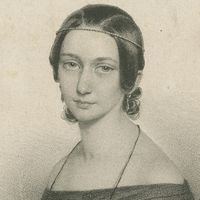Clara Schumann (13.09.1819–20.05.1896)
Clara Schumann was a concert pianist and composer. Born and raised in Leipzig, she is considered to be the most famous female concert pianist of the 19th century.

1. Biography
Clara Wieck was born on September 13, 1819 to the piano store owner and pedagogue Friedrich Wieck and the singer and pianist Mariane Wieck, née Tromlitz. After her mother separated from Friedrich Wieck in 1825, her father began a systematic instruction regime, with the goal of making Clara into a piano virtuoso. From 1830 to 1838 she undertook several concert tours with her father who acted as her manager, teacher and critic. However, soon an engagement with Robert Schumann, one of her father’s piano students, led to Clara breaking with her disapproving father and marrying the composer Schumann.
During the four years of marriage in Leipzig the Schumanns started a family with the first two of seven children: Two daughters – Mary in 1841 and Elise in 1843 – were born in Leipzig. Concertizing remained her main occupation and the revenue she gained from her concerts contributed substantially to the family’s income. She also went on concert tours under her new last name Schumann, sometimes accompanied by her husband – in 1842 a concert tour took her to Copenhagen by way of Bremen and Hamburg, in 1844 they traveled to Moscow and St. Petersburg. On the Russian tour Robert Schumann suffered both in health and nerves, so that under doctor’s orders, the family moved to Dresden in order to benefit from its presumably restorative air.
In Dresden Clara Schumann hosted musical soirées and continued to perform, however without extensive concert tours, since she had three more children during these years. In 1850 Robert Schumann was appointed music director to the city of Düsseldorf.
During their years in Düsseldorf Robert Schumann continued to suffer from nervous and depressive phases. After an unsuccessful suicide attempt in 1843, he was taken to an asylum in Endenich, near Bonn, upon his own request. That same year, Clara Schumann gave birth to their last child, Felix. In order to take care of her family, she intensified her performing career. Robert Schumann died in the asylum in 1856.
Between 1856 and 1866 Clara Schumann went on concert tours throughout all of Europe, while moving two more times. In 1878 she became the first female professor at the Dr. Hoch Conservatory in Frankfurt a.M. She gave her last public performance in 1891 at the age of 71. One year later she had to give up her teaching position for health reasons. She died on May 20th, 1896 after a second stroke.
2. Private Life
Since the young Clara Wieck was often away on concert tours with her father, her engagement to Robert Schumann took place in secret and on paper. This is documented in a touching exchange of letters. In August 1837 the 27-year-old Robert Schumann wrote to the nearly 18-year-old Clara:
A thousand times I have thought about everything and everything tells us: it must be, if we want it and we act. Just write me a simple Yes, whether you would give your father a letter from me on your birthday (on September 13).
Clara Wieck’s answer to this letter:
Just a simple “Yes” is what you require? Such a short little word – so important! Yet – should not a heart so full of unspeakable love as mine be able to express this short little word from the bottom of my soul? I do so and my inmost being whispers it to you forever. […] I too had been long feeling “it has to be”, nothing in the world shall make me stray or wander, and I will show my father that a young heart can also be steadfast!
As soon as this secret engagement with Robert Schumann was made known, Wieck sent his daughter to Paris on a concert tour by herself, hoping that she would fail there and return to him in repentance. She, however, proved her “steadfast heart” by returning triumphant from her autonomously planned concert tour and subsequently launched a court appeal together with her fiancé in order to gain permission to marry.
3. Connection to Leipzig
Childhood
Clara Wieck was born in 1819 in the house “Hohe Lilie” at the Neumarkt in Leipzig. Before her public debut in the Gewandhaus in Leipzig at nine years of age, her father had the young virtuoso perform in private circles in Leipzig and in Dresden. At sixteen years of age, she performed her own piano concerto under the baton of the new Gewandhaus director, Felix Mendelssohn Bartholdy.
Married years in Leipzig
After she married Robert Schumann in 1840, Clara Schumann continued to perform and compose. Even though she did not compose as much as her husband, she took an active part in his creative work – she expressed criticism and suggested improvements; furthermore, she saw herself as the authoritative interpreter of his works. This artist couple’s home was a place of musical encounters with many frequent visitors such as Felix Mendelssohn, Franz Liszt, Hans-Christian Andersen, Hector Berlioz, Richard Wagner, and many others. For the rest of her life, her city of birth Leipzig remained an important concert destination as well as a city with many musician friends.
4. Reception
Her contemporaries called her the “High Priestess of Art”. Her style of playing was often described with such words as “ingenious”, “soulful”, or “spirited”. It was additionally said of the “Art Prophetess” that she played “completely in the spirit of the composer”. Through her international fame (she also traveled to Great Britain 19 times in total for concert tours) she was able to put less-known compositions on her programs and in this way introduce the music of Robert Schumann, later on of Johannes Brahms as well, to her public. During her concert pianist career of over 60 years she established the solo concert for piano. Moreover, she played her concerts mostly from memory, not using the musical score; a custom that is taken for granted in today’s concert practice, but which was uncommon in the 19th century.
5. Works
Clara Schumann composed 48 of her own works and wrote numerous arrangements and editions, especially of her husband’s works.
Piano works
1831: Four Polonaises Op. 1; Leipzig: Hofmeister
1836: Quatre pièces caractéristiques Op. 5: Leipzig: Whistling
1836: Soirées musicales Op. 6: Leipzig: Hofmeister; Paris: Richault
Songs
1841: Songs (12) from Rückert’s “Liebesfrühling” Op. 12 (joint cycle with Robert Schumann, his Op. 37: Leipzig: Breitkopf & Härtel
1843/44: Six Songs Op. 13: Leipzig: Breitkopf & Härtel
Instrumental works
1837 (comp. 1833-36): Piano Concerto No. 1 in A minor Op. 7: Leipzig: Hofmeister; Paris: Richault; Hamburg: A. Cranz
1847: Piano Trio in G minor Op. 17: Leipzig: Breitkopf & Härtel
1855/56 (comp. 1853): Three Romances for Violin and Piano Op. 22: Leipzig: Breitkopf & Härtel
Audio Samples
Selected works by Beethoven, Brahms, C. & R. Schumann: https://www.schumann-portal.de/H%C3%B6rbeispiele.html#t=0:15.045
More works by Clara Schumann: http://www.pianosociety.com/pages/schumannclara/
Pianoconcert a-moll op. 7 (1834) https://www.youtube.com/watch?v=fcLtg5Ps8Rk
Six Songs, op. 13 (1843-44)https://www.youtube.com/watch?v=C6gpqXdYhi4
6. Sources and Links
Kühn, Dieter. (1998). Clara Schumann, Klavier: ein Lebensbuch. Frankfurt am Main: Fischer Taschenbuch Verlag.
Babbe, Annkatrin, Hoffmann, F., Gärtner, M., & Keil, U.B. (2015). Clara Schumann und ihre SchülerInnen am Hochschen Konservatorium in Frankfurt a.M. Oldenburg: BIS-Verlag der Carl von Ossietzky Universität Oldenburg.
Borchard, Beatrix. (2015). Clara Schumann: Ihr Leben: Eine biographische Montage. Hildesheim: Georg Olms Verlag.
Klassen, Janina (2009). Clara Schumann: Musik und Öffentlichkeit. Köln: Böhlau.
Reich, Nancy B. (2001). Clara Schumann: The Artist and the Woman. Cornell University Press.
Schumann, Robert, Schumann, Clara, & Nauhaus, Gerd (2013). Ehetagebücher: 1840-1844. Frankfurt, M.: Stroemfeld.
Schumann Portal: www.schumann-portal.de/startseite.html
Photo
Clara Wieck, gezeichnet von Andreas Staub, Robert-Schumann-Haus Zwickau




